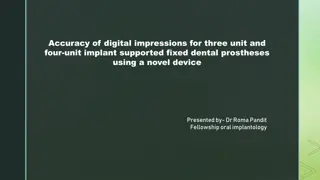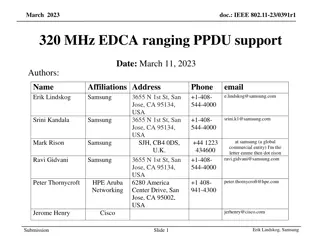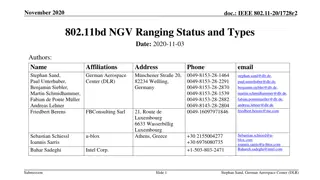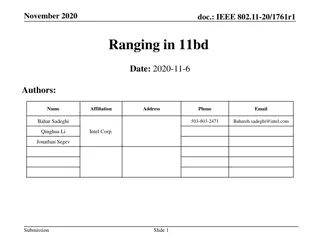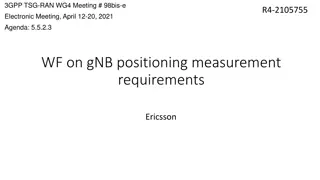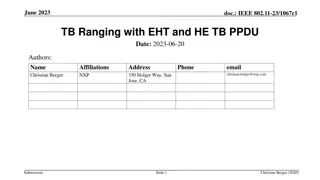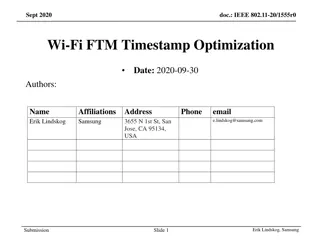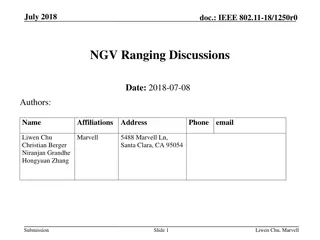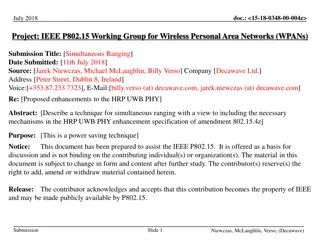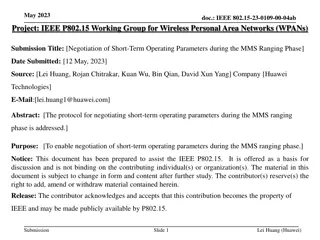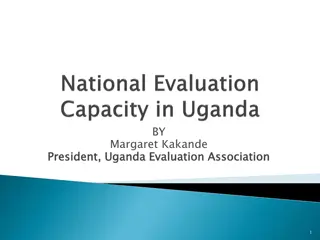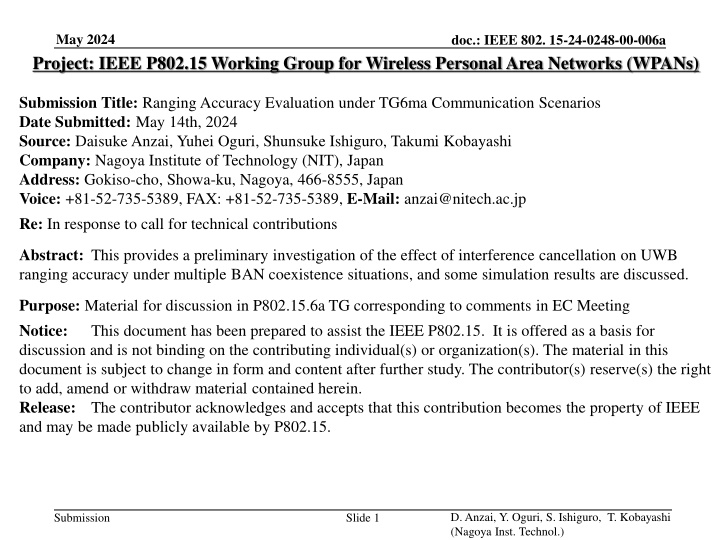
Evaluation of UWB Ranging Accuracy in Coexistence Scenarios
Explore the impact of interference cancellation on Ultra-Wideband (UWB) ranging accuracy under various Body Area Network (BAN) coexistence scenarios. This study by D. Anzai and team from Nagoya Institute of Technology delves into the implications for IEEE 802.15.6a TG discussions. Discover the significance of ranging accuracy in UWB applications and the potential for high precision in HBAN and VBAN settings.
Download Presentation

Please find below an Image/Link to download the presentation.
The content on the website is provided AS IS for your information and personal use only. It may not be sold, licensed, or shared on other websites without obtaining consent from the author. If you encounter any issues during the download, it is possible that the publisher has removed the file from their server.
You are allowed to download the files provided on this website for personal or commercial use, subject to the condition that they are used lawfully. All files are the property of their respective owners.
The content on the website is provided AS IS for your information and personal use only. It may not be sold, licensed, or shared on other websites without obtaining consent from the author.
E N D
Presentation Transcript
May 2024 Project: IEEE P802.15 Working Group for Wireless Personal Area Networks (WPANs) doc.: IEEE 802. 15-24-0248-00-006a Submission Title: Ranging Accuracy Evaluation under TG6ma Communication Scenarios Date Submitted: May 14th, 2024 Source: Daisuke Anzai, Yuhei Oguri, Shunsuke Ishiguro, Takumi Kobayashi Company: Nagoya Institute of Technology (NIT), Japan Address: Gokiso-cho, Showa-ku, Nagoya, 466-8555, Japan Voice: +81-52-735-5389, FAX: +81-52-735-5389, E-Mail: anzai@nitech.ac.jp Re: In response to call for technical contributions Abstract: This provides a preliminary investigation of the effect of interference cancellation on UWB ranging accuracy under multiple BAN coexistence situations, and some simulation results are discussed. Purpose: Material for discussion in P802.15.6a TG corresponding to comments in EC Meeting Notice: This document has been prepared to assist the IEEE P802.15. It is offered as a basis for discussion and is not binding on the contributing individual(s) or organization(s). The material in this document is subject to change in form and content after further study. The contributor(s) reserve(s) the right to add, amend or withdraw material contained herein. Release: The contributor acknowledges and accepts that this contribution becomes the property of IEEE and may be made publicly available by P802.15. D. Anzai, Y. Oguri, S. Ishiguro, T. Kobayashi (Nagoya Inst. Technol.) Submission Slide 1
May 2024 doc.: IEEE 802. 15-24-0248-00-006a Ranging Accuracy Evaluation under TG6ma Communication Scenarios Daisuke Anzai, Yuhei Oguri, Shunsuke Ishiguro, Takumi Kobayashi Nagoya Institute of Technology (NIT) D. Anzai, Y. Oguri, S. Ishiguro, T. Kobayashi (Nagoya Inst. Technol.) Submission Slide 2
May 2024 doc.: IEEE 802. 15-24-0248-00-006a Introduction Ranging is a key issue in various kinds of UWB applications, including IEEE 802.15.6ma, 4ab, and 4z UWB techniques have the potential to achieve high accuracy in supporting important applications in HBAN and VBAN It is important to discuss the ranging accuracy under multiple BAN coexistence situations under the BAN channel models D. Anzai, Y. Oguri, S. Ishiguro, T. Kobayashi (Nagoya Inst. Technol.) Submission Slide 3
May 2024 doc.: IEEE 802. 15-24-0248-00-006a UWB ranging in CFP It is more realistic that ranging is performed in contention free period (CFP), which results in the realization of both data transmission and ranging in the same period : Retransmission : Packet transmission (TDMA) Inactive Period D-Beacon DS-TWR Contention Free Period In addition to SS(Single-Sided)-TWR Measurement by switching the order of transmission and reception Accuracy is greatly improved Hub Node A Retransmission Node B Packet transmission failure Node C T SS-TWR =1 T T + T T 4 D. Anzai, Y. Oguri, S. Ishiguro, T. Kobayashi (Nagoya Inst. Technol.) Submission Slide 4 DS-TWR
May 2024 doc.: IEEE 802. 15-24-0248-00-006a Discussion items D. Anzai, Y. Oguri, S. Ishiguro, T. Kobayashi (Nagoya Inst. Technol.) Submission Slide 5
May 2024 doc.: IEEE 802. 15-24-0248-00-006a Propagation model in a hospital room[1] [1]: K. Takizawa, T. Aoyagi, H. -B. Li, J. -i. Takada, T. Kobayashi and R. Kohno, "Path loss and power delay profile channel models for wireless body area networks," 2009 IEEE Antennas and Propagation Society International Symposium, North Charleston, SC, USA, 2009, pp. 1-4. D. Anzai, Y. Oguri, S. Ishiguro, T. Kobayashi (Nagoya Inst. Technol.) Submission Slide 6
May 2024 doc.: IEEE 802. 15-24-0248-00-006a Effect of packet length SNR (Signal-to-Noise Power Ratio) Threshold coefficient ? Ratio to Maximum 0 dB 0.4 D. Anzai, Y. Oguri, S. Ishiguro, T. Kobayashi (Nagoya Inst. Technol.) Submission Slide 7
May 2024 doc.: IEEE 802. 15-24-0248-00-006a Effect of packet length SNR (Signal-to-Noise Power Ratio) Threshold coefficient ? Ratio to Maximum 0 dB 0.4 D. Anzai, Y. Oguri, S. Ishiguro, T. Kobayashi (Nagoya Inst. Technol.) Submission Slide 8
May 2024 doc.: IEEE 802. 15-24-0248-00-006a Ranging performance evaluation 0.4 Threshold coefficient ? Ratio to Maximum) Maximum of packet length [Byte] Clock drift [ppm] Pattern A: 15[bits], Pattern B: 31[bits], Pattern C: 63[bits] 2000 5 D. Anzai, Y. Oguri, S. Ishiguro, T. Kobayashi (Nagoya Inst. Technol.) Submission Slide 9
May 2024 doc.: IEEE 802. 15-24-0248-00-006a References 1. D. Anzai, I. Balasingham, G. Fischer, J. Wang, Reliable and High-Speed Implant Ultra-Wideband Communications Diversity, EAI/Springer Innovations in Communication and Computing, pp. 27-32, March 2020. Y. Shimizu, D. Anzai, R. C-Santiago, P. A. Floor, I. Balasingham, and J. Wang, Performance evaluation of an ultra-wideband transmit diversity in a living animal experiment IEEE Trans. Microw. Theory Tech., vol. 65, no. 7, pp. 2596-2606, July 2017. D. Anzai, K. Katsu, R. Chavez-Santiago, Q. Wang, D. Plettemeier, J. Wang, and I. Balasingham, Experimental evaluation of implant UWB-IR transmission with living animal for body area networks, IEEE Trans. Microw. Theory Tech., vol. 62, no. 1, pp. 183-192, Jan. 2014. J. Shi, D. Anzai, and J. Wang, Channel modeling and performance analysis of diversity reception for implant UWB wireless link, IEICE Trans. Commun., no. E95-B, vol. 10, pp. 3197-3205, Oct. 2012. with Transmit Receive 2. 3. 4. D. Anzai, Y. Oguri, S. Ishiguro, T. Kobayashi (Nagoya Inst. Technol.) Submission Slide 10

